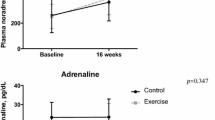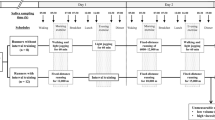Summary
Serum and salivary cortisol concentrations were studied in 78 elite athletes engaged in different sports, by subjecting them to high-intensity laboratory exercise. The mean difference in the pre-exercise cortisol concentrations in the seven groups studied were more marked in serum (from 311 to 768 nmol · l−1) than in saliva (from 17.9 to 22.7 nmol · 1−1, only one group reaching 40 nmol ·−1). Judging from the correlation coefficients based on total variances, the post-/pre-exercise differences in cortisol concentrations in serum depended chiefly on pre-exercise values, while those in saliva tended to depend more on the postexercise concentrations. The coefficients of correlation between that difference and either the pre- or postexercise values were −0.71 and 0.47, respectively, for serum, and −0.51 and 0.58, respectively, for saliva. This would suggest that salivary cortisol concentration might be a more suitable variable for assessing glucocorticoid activity in exercise than serum cortisol concentration, probably being less sensitive to pre-exercise emotional state.
Similar content being viewed by others
References
Cook NJ, Ng A, Read GF, Harris B, Riad-Fahmy D (1987) Salivary cortisol for monitoring adrenal activity during marathon runs. Horm Res 25:18–23
Métivier G (1975) The effects of long-lasting physical exercise and training on hormonal regulation. In: Howald H, Poortmans JS (eds) Metabolic adaptation to prolonged physical exercise. Birkhauser, Basel
Obminski Z (1990) Exercise-induced changes in the biologically active fraction of cortisol in athletes (in Polish). Thesis, Institute of Sport, Warsaw
Obminski Z, Stupnicki R (1990) Relations between cortisol in saliva, total and free cortisol and transcortin in serum. In: Görög S (ed) Advances in steroid analysis. Akademiai Kiado, Budapest, pp 453–458
Obminski Z, Stupnicki R (1992) Radioimmunoassay of cortisol in saliva. Endokrynol Pol 42:491–497
O'Connor PJ, Corrigan DL (1987) Influence of short-term cycling on salivary cortisol levels. Med Sci Sports 19:224–228
Port K (1991) Serum and saliva cortisol responses and blood lactate accumulation during incremental exercise testing. Int J Sports Med 12:490–494
Riad-Fahmy D, Read GF, Walker RF, Griffiths K (1982) Steroids in saliva for assessing endocrine function. Endocr Rev 3:367–395
Riad-Fahmy D, Read GF, Walker RF (1983) Salivary steroid assays for assessing variation in endocrine activity. J Steroid Biochem 19:265–272
Stahl F, Dörner G (1982) Responses of salivary cortisol levels to stress-situations. Endokrinologie 80:158–162
Stupnicki R (1985) Glucocorticoids. In: Kokot F, Stupnicki R (eds) Radioimmuno- and protein binding assays in the clinical laboratory (in Polish). PZWL, Warsaw, pp 235–244
Stupicki R, Obuchowicz-Fidelus B, Jedlikowski P, Klusiewicz A (1992) Serum cortisol, growth hormone, and physiological responses to laboratory exercise in male and female rowers. Biol Sport 9:17–23
Umeda T, Hiramatsu R, Iwaoka T, Shimada T, Miura F, Sato M (1981) Use of saliva for monitoring unbound free cortisol levels in serum. Clin Chim Acta 110:245–253
Vervoorn C, Quist A, Vermulst L, Erich W, de Vries W, Thijssen J (1991) The behaviour of the plasma free testosterone/cortisol ratio during a season of elite rowing training. Int J Sports Med 12:257–263
Vining RF, McGinley RA, Maksvytis JJ, Ho KY (1983) Salivary cortisol: a better measure of adrenal cortical function than serum cortisol. Ann Clin Biochem 20:329–335
Vining RF, McGinley RA (1985) Hormones in saliva. CRC Crit Rev Clin Lab Sci 23:95–146
Author information
Authors and Affiliations
Rights and permissions
About this article
Cite this article
Stupnicki, R., Obminski, Z. Glucocorticoid response to exercise as measured by serum and salivary cortisol. Europ. J. Appl. Physiol. 65, 546–549 (1992). https://doi.org/10.1007/BF00602363
Accepted:
Issue Date:
DOI: https://doi.org/10.1007/BF00602363




